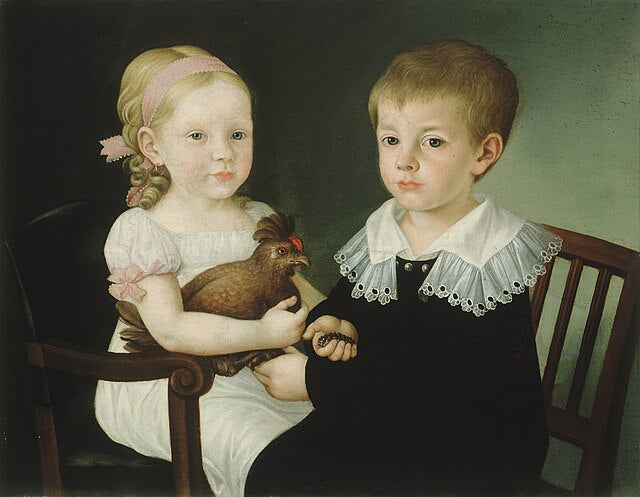Article: Dressing the Part: Children's Clothing in Regency
Dressing the Part: Children's Clothing in Regency
Children's Clothing in Regency and how it evolved
For the first time in History, around 1770, children began to have clothes that were designed just for them; they were no longer dressed as miniature adults. This is very noticeable in portraits of the time, the adults still wearing stiff formal costumes, while the children appear relaxed and free; the boys in shirts which are open at the neck, the girls in simple gowns with a sash at the waist.

Many experts attribute this, at least in part, to the influence of Rousseau. In 'Emile', published in 1762, translated into English the following year, he dealt not only with methods of raising children, but also with their clothing. "The limbs of a growing child should be free to move easily in his clothes: nothing should cramp their grown or movement; there should be nothing tight, nothing fitting closely to the body, no belt of any kind. The plainest and most comfortable clothes, those which leave him the most liberty, are what he likes best." How different from the boned and panniered dresses for girls and the satin suits for little boys of previous times. Naturally, this process was not an instant change, but by 1800 it had permeated all levels of society. The most significant fact is that what the children wore gradually became the model for adult clothes. Thus, a young girl born about 1770 would wear almost the same style until she was 50! The "trousers" which were part of the boys costume were almost universal by 1830 for adult males and are still their most important garment today.

Later in the period, when skirts became shorter, girl's nether garments began to be shown. In 1811, there is a description of Princess Charlotte, then 15 years old, talking to Lady de Clifford and "sitting with her legs stretched out after dinner and show[ing] her drawers which it seems she had and most young women now wear." It was considered that the Princess was now too old for such a display, but she countered that the Duchess of Bedfort showed even more of her drawers. In winter, dresses may have been made of wool, and flannel petticoats worn. The neck and chest were very much exposed in this style and spencers and tippets worn for warmth. Cloaks would be worn for traveling and shawls and stoles made their appearance for the fashionable child. Dress your own Regency fashion girl, click here for our range of children's dress patterns and paper dolls!


1 comment
quote from this article “…The most significant fact is that what the children wore gradually became the model for adult clothes. Thus, a young girl born about 1770 would wear almost the same style until she was 50!…”
This article indirectly offers more proof that the Rice portrait is likely young teen Jane Austen. Some say the picture couldn’t be a 1780s portrait of Jane Austen because of her style of dress (which was not worn by grown women till some years later).
It is likely that young 12 or 13 year old Jane Austen appears in the portrait wearing a comfortable empire style gown (which little girls of that era wore…). She is not yet “out” in society (I’m assuming) and as an active girl who likes the outdoors, living not in a fancy city but in the country, probably she was still dressed in the comfortable child’s wear of the late 1700s.Anonymous
Leave a comment
This site is protected by hCaptcha and the hCaptcha Privacy Policy and Terms of Service apply.